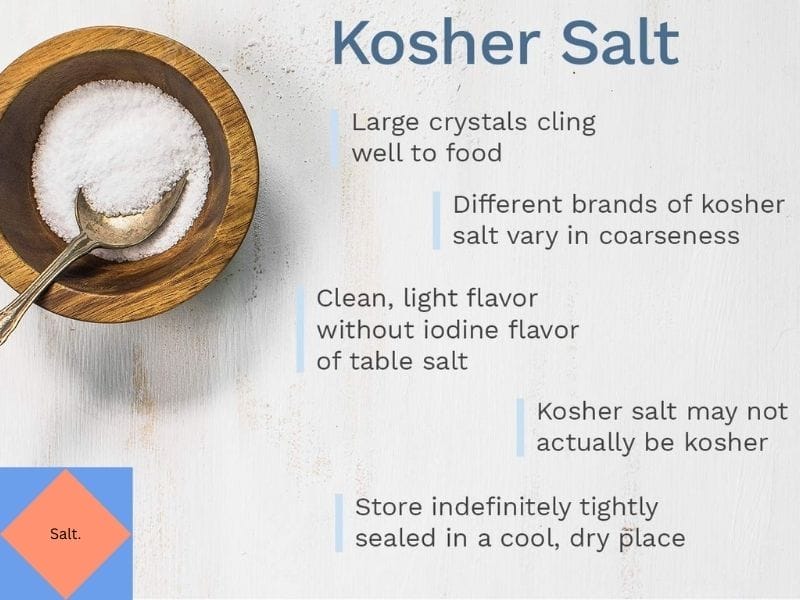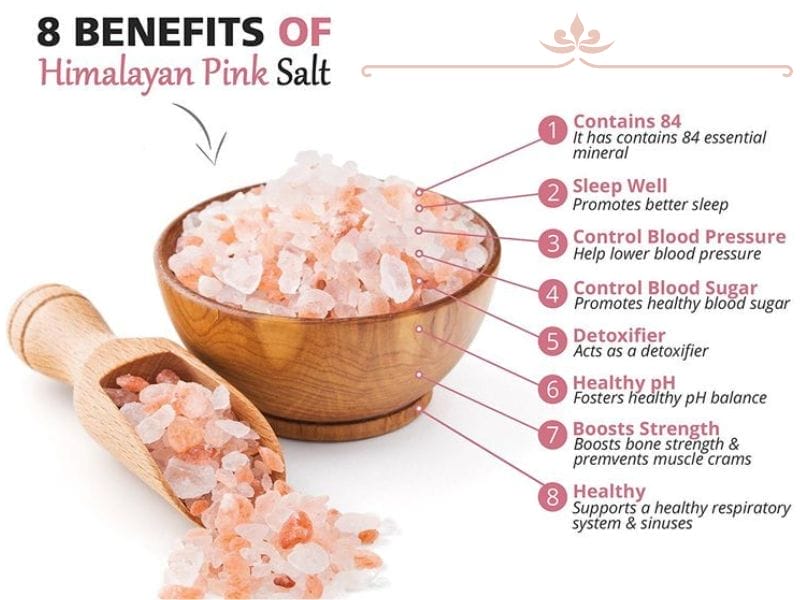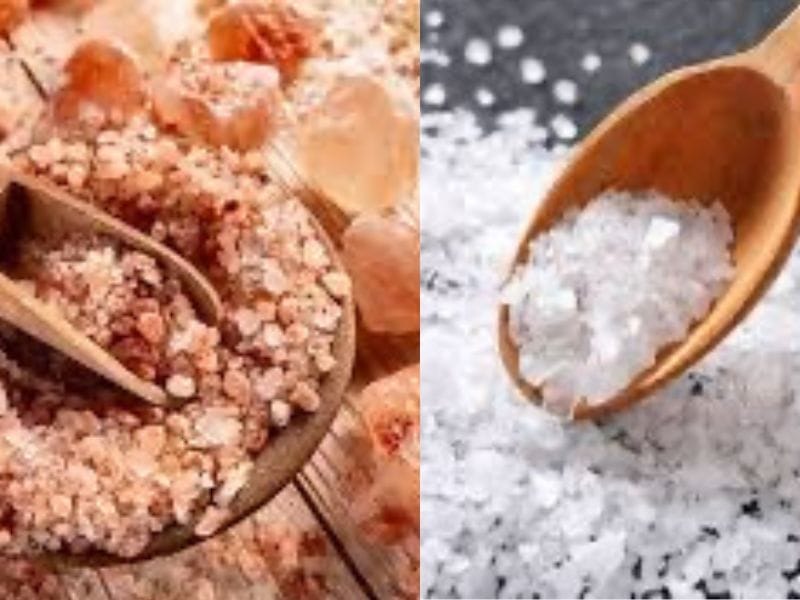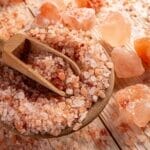Salt is a staple in every kitchen. Regardless of culture, country, or level of expertise, salt will always play a large role in flavor enhancement, food preservation, and biology. Because of this overwhelming demand for salt in every aspect of our lives, there is a large variety of options. So which one do you choose? Let’s begin by discussing two popular choices you’ll often encounter in supermarkets: Kosher salt vs Himalayan salt. They both have their unique attributes, that make them great options, but if we compare them, which one wins?

Kosher Salt: The Chef’s Choice
What is Kosher Salt?
Kosher salt is named after its role in the koshering process. This is a method in Jewish practices that helps remove blood from meat. This salt is without additives and is coarse-grained.
If you prefer a clean, unaltered pure taste then this salt definitely takes the cake. It has larger irregular crystals that you can easily pinch and sprinkle into your food or use as toppings, and it dissolves well by clinging onto the surface of the food. This makes the dish taste delectable without salt being the only flavor you taste. But what makes this a really great option is that it is cheap and available everywhere. You won’t have to worry about running out and not finding kosher salt because every supermarket has it!
On the flip side, kosher salt doesn’t have as many nutrients and minerals as lots of other salt options. It’s definitely pure sodium chloride but it has no trace of magnesium or potassium. Their irregular shape that helps them cling to food may also be a downside. It takes up more volume which might cause you to underseason the sun if you follow instructions. So with regards to nutrients and minirals, in the battle of The debate between kosher salt vs Himalayan salt, the Himalayan salt has more points.

Himalayan Salt: The Pink Wonder
What is Himalayan Salt?
Himalayan salt is practically pink gold. It is mined from the sea beds under the Himalayan mountains, primarily in the Khewera mines of Pakistan. The pink hue is derived from over 80 trace minerals like magnesium, potassium, and calcium. This salt is one of the healthier options sold at supermarkets. This salt’s benefits do not stop at its culinary applications, but its pink color allows for it to contribute to the aesthetic appeal of any space.
The health benefits go beyond our internal regulations, they also contribute to skin health and hydration. But the most convenient aspect of this salt is how it comes in a variety of forms. Whether you want coarse grains, blocks, or even lamps for air purifying benefits, you can probably find it.
All things with several benefits also have their drawbacks. For starters, Himalayan pink salt is more expensive than other types of salt like kosher salt. Sure the mineral trace content is very high, but the quantity of salt consumed isn’t significant enough to obtain those health benefits. Lastly, depending on where you live, you might not be able to find Himalayan pink salt. The debate between kosher salt vs Himalayan salt goes on.

Kosher Salt vs. Himalayan Salt
Flavor and Texture: Kosher Salt vs Himalayan Salt
Kosher salt doesn’t contain that many minerals so it doesn’t overwhelm dishes with several different mineral traces. It has large, flaky grains that add a satisfying crunch to your favorite dishes.
Himalayan Salt is a form of salt that contains several minerals so its salty taste is shadowed by mineral undertones making it much milder. Luckily its fine grains dissolve quicker and the coarse varieties can Offer a slightly milder flavor compared to Kosher salt, with subtle mineral undertones. Its fine grains dissolve quickly, but coarse varieties can add a similar crunch to Kosher salt. The debate between kosher salt vs Himalayan salt goes on.

Health Aspects: Kosher Salt vs Himalayan Salt
Kosher Salt: this salt is simply pure sodium chloride. It has no added iodine making it better suited for food because it does not alter the taste. Due to its lack of minerals, it doesn’t have any health benefits besides the fact that it is a salt that attracts moisture and can help regulate pH balance and hydration within the body.
Himalayan Salt has several trace minerals but the health benefits are overstated. The added color makes the flavors slightly more complex, however, you will still need to eat a balanced diet. The Himalayan salt is not magic.
Cooking and Culinary Uses: Kosher salt vs Himalayan salt
Kosher Salt: if salt is part of the decor and finishing touches, or preserving meat, kosher salt is a great choice. The texture of the salt makes it one of the easiest types of salt to use.
Himalayan Salt: when you want a pink hue or a colored finishing appeal, then this salt is the way to go. A famous type of cooking method is salt block cooking which is when food is prepared on a heated slab of Himalayan salt.
So here in the battle of The debate between kosher salt vs Himalayan salt, the Himalayan salt has more points.

Cost and Availability: Kosher Salt vs Himalayan Salt
Kosher Salt: Not only is this more affordable but it’s also widely available. It’s a more practical choice for everyday cooking as you can easily pop into the supermarket and grab it without worrying about availability.
Himalayan Salt: this is rare and very unique. with the abundance of health benefits, this salt is also more expensive and sometimes harder to find. If you’re looking to change your lifestyle one small step at a time, this salt might be the one for you. So in the battle between The debate between kosher salt vs Himalayan salt, here Kosher salt has more points with regards to cost and availability.
The debate between kosher salt vs Himalayan salt is entirely based on preference. it’s based on what you plan on cooking if you wish to avail extra benefits besides a delectable salty taste or if you are looking for something quick and convenient.
Q. Can I use Kosher salt and Himalayan salt interchangeably?
you can substitute one salt for the other but be careful to adjust the quantities. Kosher salt has a stronger salty taste, whereas Himalayan salt is milder, so you might need more of it. If a recipe calls for a teaspoon of table salt, you might want to use 1.5 teaspoons of Himalayan salt or kosher salt.
Q. Is one type of salt healthier than the other?
The health differences are minimal. Himalayan salt has trace minerals, but they’re present in such small amounts that they don’t make a huge difference to overall health. Both salts are essentially sodium chloride and should be consumed in moderation.
Q. Why do chefs prefer Kosher salt?
Chefs favor Kosher salt because of how easy it is to use. The texture makes it simple to pinch and control the large flaky grains. This prevents the dishes from becoming over-salted.
Q. Does Himalayan salt have more flavor than Kosher salt?
Himalayan salt does not have more flavor than kosher salt. The Himalayan salt has subtle flavor differences because of its high mineral trace content.
Q. Can I use Himalayan salt in baking?
Yes, but be mindful of its grain size. Fine Himalayan salt works well in baking, while coarser grains might not dissolve completely, leading to uneven seasoning.
Q. What’s the best way to store these salts?
Always store salt in a cool, dry place in an airtight container to prevent clumping and moisture absorption.
Differences Between Sea Salt and Table Salt:
Sea Salt is harvested from evaporated seawater, so it contains trace minerals that add a unique flavor and color. It has a coarse, thicker texture and is often used as a finishing salt. Whereas, table Salt is refined and contains no trace minerals. It has added iodine and anti-caking agents which give it a uniform texture ideal for baking.
Best Salts for Cooking and Finishing:
The best options for cooking are fine sea salt and Kosher salt due to their texture and purity. these salts tend to only contribute to the saltiness of the dish rather than add extra flavoring. their thicker texture means they mold better to the food when they melt and can be controlled easier when pinching and sprinkling. When your purpose is finishing, then you want to pick a salt that is larger and flaky, such as Maldon, and Himalayan salt. They are perfect for sprinkling on finished dishes to add complex of flavors and visual appeal.
Health Benefits of Pink Himalayan Salt:
The list if benefits for pink Himalayan salt is endless. This is because of its large trace mineral content like magnesium, potassium, and calcium, which support muscle and bone strength, hydration, pH balance, and glowing skin.
Culinary Uses of Different Types of Salt:
Use table salt for baking, because measurements are crucial, and table salt has the same sized fine grains. Kosher Salt is Ideal for seasoning and brining due to its large grains and pure taste. Sea Salt is great to sprinkle over your brown butter cookies to balance out the sweetness by letting its mineral content shine. Lastly, Himalayan salt’s pink hue makes this salt great for finishing, cooking on salt blocks, or adding a unique touch to dishes.
Himalayan Salt Lamps: Benefits and Myths
Himalayan salt lamps can be used for halotherapy and can be used to improve air quality. Not only are these lamps beautiful and unique, but their presence in your room can clean out the toxins in the air and boost mood by making you feel more relaxed
Final Thoughts on Kosher Salt vs Himalayan Salt
When it comes to Kosher salt vs Himalayan salt, the choice is up to a personal preference. Both salts contain minerals and have their own merits, however, the salt you purchase largely depends on your culinary needs. Kosher salt is perfect for everyday cooking because it’s accessible, cost-friendly, and has a clean taste. Himalayan salt’s trace mineral and pink color are much more elegant and are for people who prefer complex tastes and health benefits.
In the end, both salts have their place in and out of the kitchen. Whether you’re seasoning a steak, baking bread, or garnishing a salad, choosing the right salt can take your dish to the next level.






0 Comments